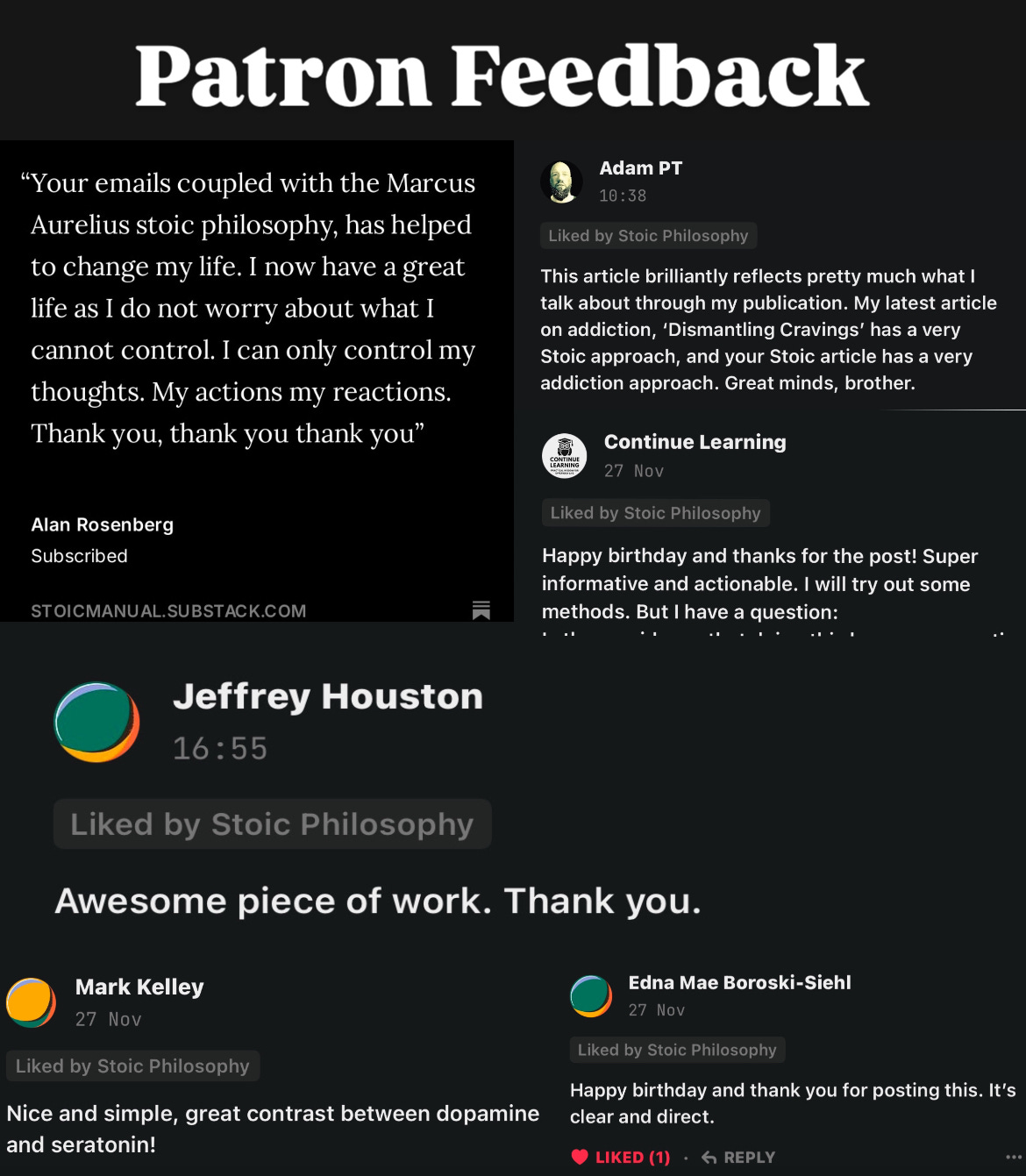#12. The Neuroscience of Making and Breaking Habits: A Comprehensive Guide
Celebrate behaving like a human—however imperfectly—and fully embrace the pursuit that you've embarked on.
The ‘Neuroscience-based Tools’ section is a companion for The Stoic Manual to help you become wealthier, happier & more powerful by boosting your resilience, drive, mood, motivation, relationships, focus, and overall health—by Dr. Antonius Veritas. Complement this with the ‘Lead to Win’ section.
P.S: Skip to the end for a Comprehensive Guide to help you Create and Maintain Good Habits. You’ll also get a Notion Habit Tracker to help you stick to the plan. All worth $3,500.
Happy New Year everyone!🥂
Say it back! :)
2024 has been a beautiful year, replete with growth and accomplishments beyond my wildest dreams.
A year and some change ago we started this publication with 0 subscribers.
Now we’re at over 10,000 subscribers and going strong.
I’ve also published over 124 entries—all full of premium information and practical strategies to help you implement this quality education in real life.
I can’t wait to see what 2025 has in store for us.
I have a lot planned out so you can be the all-rounded and elite Stoic following in the footsteps of Seneca, Marcus Aurelius, and Epictetus.
So you’re better equipped to handle anything life throws at you and flourish in whatever path you choose.
For greatness is your destiny.
Thank you for the overwhelming support!
I also know some of you didn’t get to accomplish everything you wanted because of various reasons.
But Marcus Aurelius would tell you,
“Not to feel exasperated, or defeated, or despondent because your days aren't packed with wise and moral actions.
But to get back up when you fail, to celebrate behaving like a human—however imperfectly—and fully embrace the pursuit that you've embarked on.”
Celebrate behaving like a human being.
We’ve been given another chance.
The chance to get back on track and conquer 2025.
We get the chance to demand the best from ourselves again—as we’ve spoken about before.
Others think they’d have done more.
And I understand you.
Yet, we can’t wallow in regrets and self-pity.
We have to accept failure as part of the process, dust ourselves, and maintain forward momentum.
That’s why I want us to approach 2025 strategically.
I want us to actually achieve our goals and reflect in gratitude and joy at the end of the year.
Hence, today you’ll learn how to accomplish your goals through the science and power of habits.
See, habits are the silent architects of our lives.
They dictate how we navigate the world, how we achieve our goals, and even how we limit ourselves.
The science behind habit formation and disruption has undergone a renaissance in recent years, revealing profound insights into the brain's ability to learn, adapt, and solidify behavioral patterns.
This essay dives deep into the biology of habits, exploring how they form, how they can be broken, and how we can use neuroscience to design the lives we want.
Stoic Habit Building Resources:
The Biology of Habit Formation
Habit formation is a function of neuroplasticity—the brain's capacity to rewire itself in response to experiences.
When we repeat a behavior, the neural circuits associated with that action strengthen through a process called Hebbian learning (“neurons that fire together, wire together”).
This involves:
1. Synaptic Strengthening
Repeated behaviors enhance the connections between neurons, making the behavior more automatic over time.
Each repetition reinforces the neural pathways, reducing the energy required to execute the habit and embedding it in procedural memory.
2. Activation of the Basal Ganglia
The dorsolateral striatum, a subregion of the basal ganglia, becomes critical in encoding the beginning and end of habits.
This process, known as task bracketing, ensures that habits are initiated and completed efficiently by creating robust neural markers around habitual sequences.
The basal ganglia’s role highlights the importance of routine in sustaining habits and demonstrates why disrupting task boundaries can lead to habit breakdown.
3. Procedural Memory Development
Unlike episodic memory (which recalls events), procedural memory encodes the steps required to perform tasks.
This transformation turns deliberate actions into reflexive routines.
Procedural memory allows complex behaviors—like driving, exercising, or writing—to be executed without active mental effort, conserving cognitive resources for other tasks.
Dopamine: The Habit Driver
Dopamine, the neurotransmitter of reward and motivation, plays a pivotal role in habit formation.
Resource
Dopamine’s influence is multifaceted:
Reward Anticipation and Reinforcement
Dopamine is released when we anticipate or achieve a reward, creating a feedback loop that strengthens the neural circuits associated with the behavior.
This mechanism ensures that habits aligned with perceived rewards become deeply ingrained over time.
Reward Prediction Error
The magnitude of dopamine release depends on the alignment between expectation and outcome.
Unexpected Rewards generate the highest dopamine surges, supercharging the reinforcement of behaviors and making them more likely to recur.
This underscores the power of novelty in habit formation.
Expected but Absent Rewards result in a dopamine dip, weakening the neural reinforcement and discouraging repeated behavior.
The Role of Intermittent Rewards
Leveraging unpredictable rewards strategically—such as celebrating small wins or offering surprise incentives—can amplify motivation.
Intermittent reinforcement mirrors principles used in addictive technologies and gamification, providing powerful insights for creating sustainable habits.
The Complexity of Habitual Neural Networks
Neural pathways involved in habits are not limited to individual circuits; they integrate sensory, motor, and emotional inputs.
The dorsolateral striatum's interaction with the prefrontal cortex—responsible for planning and decision-making—allows habits to operate in tandem with conscious goals.
Over time, as habits become automated, prefrontal involvement diminishes, freeing up cognitive bandwidth for other challenges.
The Concept of Limbic Friction
Limbic friction refers to the internal resistance we feel when initiating or avoiding behaviors.
This friction arises from two primary states:
High Activation
Overwhelm, anxiety, or heightened arousal prevents calm execution, often making high-effort tasks daunting.
Resource
Low Activation
Fatigue, apathy, or low arousal inhibits motivation, stalling even low-effort actions.
Reducing limbic friction is critical for consistent habit execution.
Effective strategies to bypass Limbic friction include:
A. Visualization
Mentally rehearsing the sequence of steps required for the habit primes procedural memory.
By engaging the hippocampus and neocortex, visualization strengthens neural pathways and reduces the cognitive load of initiation.
B. Physical State Manipulation
Techniques like cold exposure, strategic caffeine intake, or controlled breathing modulate autonomic arousal, aligning mental and physical states with task demands.
C. Ritual Design
Anchoring habits to predictable pre-action rituals—like putting on workout gear or opening a study journal—reduces decision fatigue and limbic friction, easing the transition into action.
Breaking Habits: The Science of Disruption
Disrupting habits requires dismantling the neural circuits that support them.
This process involves a targeted strategy:
Relevant resource:
Introducing Friction
Increase the difficulty of the habit by altering environmental cues.
For example, moving tempting snacks out of sight or placing obstacles between oneself and habitual behaviors adds deliberate resistance.
Reprogramming Triggers
Identify the cues that initiate the habit and replace the automatic response with an intentional alternative.
For instance, substituting a mindfulness exercise for scrolling social media when feeling stressed creates a new pathway.
Dopamine Reassociation
Reward the replacement behavior—however small—to rewire the brain’s reward circuits.
Over time, the new behavior supplants the old habit through competitive neural plasticity.
The Interplay Between Environment and Neural Plasticity
Context dependence plays a pivotal role in habit strength.
Weak habits often rely on specific environments, making them fragile and easier to disrupt.
By systematically varying the context of habit execution, you can build robust, context-independent behaviors that persist across diverse settings.
Key to this approach is leveraging the brain’s ability to generalize learned behaviors while simultaneously avoiding the pitfalls of overly rigid routines.
For example, practicing mindfulness at different times and locations enhances flexibility and resilience in habit maintenance.
Through a nuanced understanding of neural dynamics and deliberate intervention, habits can be both forged and broken with precision.
This process transforms habits from unconscious determinants of behavior into conscious tools for personal growth.
The Comprehensive Guide to Design Your Habits Through Phased Neuroscience
Understanding how the brain’s neurochemistry fluctuates throughout the day provides a powerful framework for optimizing habit formation.
By dividing the day into three phases based on neurochemical activity, you can align specific tasks with your brain’s natural rhythms
You then get to enhance both efficiency and sustainability.
The key is to recognize that different activities demand varying levels of cognitive and physical effort.
This phased approach maximizes success by syncing these demands with the brain’s evolving capacity throughout the day.
You’ll also get a cool Habit Tracker for your progress, thanks to the Notion platform.
Let’s explore each phase in detail:
Do you like this entry so far? ⭐️
Support the publication to read the rest and access 124+ premium essays, neuroscience-based tools & meditations.
Join 13,000+ other readers.
What my supporters are saying.


















